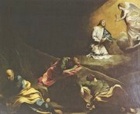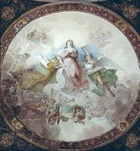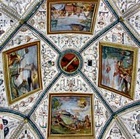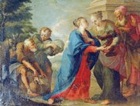This page describes:
-
✴the crypt;
-
✴three chapels off the left aisle, starting from the chapel nearest the counter-facade:
-
•the Cappella del Sacramento;
-
•the Cappella Ranieri; and
-
•the Cappella Vibi;
-
✴two chapels off the right aisle:
-
•the Cappella delle Reliquie, at the end of the aisle; and
-
•the Cappella di San Giuseppe; and
-
✴the sacristy, which is between these last two chapels.
Crypt
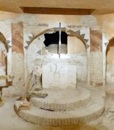
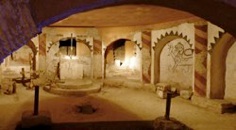
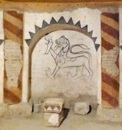
Steps in the left aisle lead down to the crypt.
This was originally a twelve-sided structure that seems to have been a paleochristian mausoleum. The wall of the bay containing the altar and those of the bay to each side of it provided the foundations for the apse of the later church. It formed the crypt of this later structure until the 16th century, when it was closed.
The graffiti (15th century) in the 2nd arch to the right of the altar is probably the coat of arms of a noble family of Perugia.
Cappella del Sacramento (1760-3)
The original chapel here was built in 1643 to house the highly venerated Madonna del Giglio (see below). It was demolished in 1760 to make way for the present chapel.
Madonna del Giglio (1433)
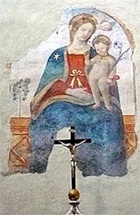
Panels by Giorgio Vasari (1566)
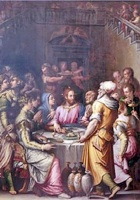
-
✴a miracle of Elisha (on the right wall);
-
✴a miracle of St Benedict (also on the right wall); and
-
✴the feast at Cana (on the left wall, illustrated here).
These subjects, which all involve miracles that occurred during meals, were of course appropriate for the original location in the refectory.
Frescoes (1762-3)
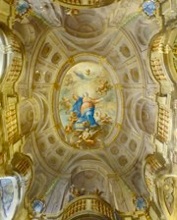
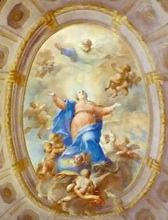
These frescoes in the vaults by Francesco Appiani are set in a fictive perspectival background by Pietro Carattoli.
Cappella Ranieri (1506)
Francesco di Guido di Virio da Settignano built this chapel for Donna Leonarda Olivieri Baglioni. It subsequently passed to the Ranieri family.
Frescoes (1529)
The frescoes in this chapel by Giovanni Battista Caporali were subsequently over-painted.
Agony in the Garden (17th century)
Assumption of the Virgin (1863)
Cappella Vibi (remodelled in 1506)
Francesco di Guido di Virio da Settignano re-modelled this chapel for Baglione di Ugolino dei Montevibiani. The contract specified that this re-modelling was to be the design of what is now Cappella Ranieri (see above).
Marble altarpiece (1473)
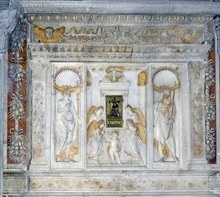
This gilded marble altarpiece is attributed to Mino da Fiesole. The inscription records the date and the name of the donor, Baglione dei Montevibiani. The central panel contains the door of a tabernacle with a relief of the Pietà. The baby Jesus stands below it, flanked by angels. SS Jerome and John the Baptist are modelled in deep relief in fictive niches to the sides.
Frescoes (1521)
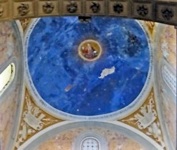

Giovanni Battista Caporali was commissioned to execute the (now very damaged) frescoes in the chapel.
Madonna of the Lilies (1632-6)
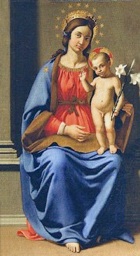
[Has this moved to the Galleria Tesori d’Arte ??]
Cappella delle Reliquie
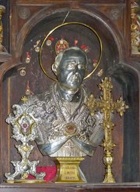
Frescoes (1599)
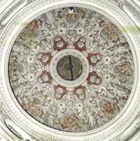
Cappella di San Giuseppe
Frescoes (1857)

Sacristy (1451)
Unfortunately, the original stained glass windows (15th century), which were designed by Benedetto Bonfigli, have been destroyed.
The inlaid cabinets in the sacristy date to 1472.
Traces of the majolica floor (1563-4) survive in front of it and under the table.
Frescoes (late 16th century)
Scenes from the lives of SS Peter and Paul (1574)
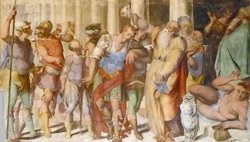
These frescoes on the walls, which are dated from documents, are attributed to Girolamo Danti. (He is not specifically mentioned in connection with these frescoes, but he is documented in connection with a number of other works in San Pietro at this time, none of which survive). The frescoes in the sacristy depict:
-
✴the baptism of Saul (later St Paul), illustrated here;
-
✴St Peter baptising the centurion Cornelius;
-
✴St Peter’s vision of a sheet full of animals that God commanded him tho eat;
-
✴the attempted sacrifice to SS Paul and Barnabus at Lystra, after they had cured a lame man; and
-
✴the death of Ananias, after he had lied to St Peter.
Predella panels from San Pietro Polyptych (1495-1500)

These panels by Perugino were separated from the rest of the polyptych (described in the page Art from San Pietro) when it was removed and dismantled in 1608. They remained in San Pietro until 1811, when Agostino Tofanelli secured them for the Musei Capitolini, Rome. They were returned to Perugia in 1815.
The panels depict:
-
✴St Scholastica (the sister of St Benedict);
-
✴St Herculanus;
-
✴St Peter Abbot (the founder of San Pietro);
-
✴St Constantius; and
-
✴St Maurus.
The panel of St Scholastica, which is badly damaged, was stolen in 1916 and returned in 1993.
Infants Christ and St John the Baptist (early 16th century)
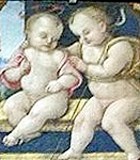
Madonna and Child with St Joseph (16th century)
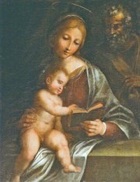
Christ blessing (16th century)
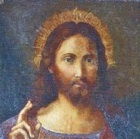
St Frances of Rome instructed by an angel (17th century)
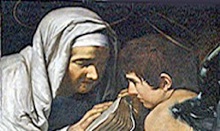
This small panel, which is on the entrance wall, taken to Rome in 1811 by Agostino Tofanelli, Director of the Musei Capitolini and returned to San Pietro after the fall of Napoleon in 1815. It was attributed to Caravaggio at this time, but was subsequently re-attributed to his follower, Giovanni Antonio Galli, lo Spadarino.
[St Frances (1384-1440) was the founder of a lay community affiliated to the Benedictines that was dedicated to helping the poor of Rome. She was canonised in 1608.]
Visitation (18th century)
San Pietro: Main Page Exterior Church Interior
Crypt, Chapels and Sacristy Art from San Pietro
Return to Monuments of Perugia.
Return to Walk IV.


